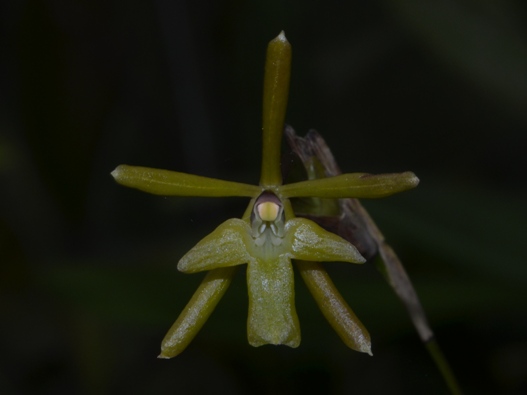

Epidendrum nora-mesae Hágsater & O.Pérez 2010 GROUP Alberti SUBGROUP Convergens
Photo by © Nissen and the The Orquideas del Valle Website
Photo by © Gustavo Adolfo Aguirre and The Sociedad Colombiana de Orquideologia Website
TYPE Drawing by © Jimenez, Hágsater & E.Santiago and The AMO Herbario Website







Common Name Dr Nora Mesa's Epidendrum [Colombian Professor of Entomology at the Universidad Nacional in Valle De Cauca current]
Flower Size 1" [2.5 cm]
Found in Colombia in cloud forests at elevations of 1800 to 2260 meters as a small to medium sized, cool to cold growing epiphyte with an erect when young, arching-pendent with age, simple, cane-like, laterally compressed, ancipitous stem carrying 5 to 7, all along the stem, alternate, articulate, suberect, progressively longer, subcoriaceous, lanceolate, acuminate, margin entire, spreading leaves that blooms at most any time of the year on a terminal, on a mature stem, racemose to pluriracemose, distichous, peduncle elongate, laterally compressed, ancipitous, two winged, the wings prominent towards the base, rachis short, totally enveloped by the floral bracts, 5.6 to 7.6" [14 to 19 cm] long, successively single, 3 to several flowered inflorescence with much shorter than the ovary, narrowly elliptic, obtuse, conduplicate, imbricating, persistent even after flowering floral bracts.
"Epidendrum nora-mesae belongs to the GROUP Alberti which is characterized by the sympodial habit, laterally compressed to ancipitose or somewhat fusiform-thickened stems, the apical or apical and lateral racemose, distichous inflorescence more or less with imbricating bracts on the peduncle, producing one flower at a time, and the SUBGROUP Convergens which is characterized by the stems with numerous leaves, the apical, rarely lateral inflorescence, peduncle elongate, bare, non-bract bearing, two-winged, the rachis short, covered by rounded, usually imbricating bracts, a 3-lobed lip and 8 pollinia. The species is recognized by the plants up to 14.3 [37.2 cm] tall (including the inflorescence), lanceolate leaves .8 to 4.8" x .16 to .96" [2 to 12 x 0.4 to 2.4 cm], the inflorescence visibly longer than the apical leaf, sepals .56 to .84" [14 to 21 mm] long, the deeply 3-lobed lip, the mid–lobe obcuneate, and the lateral lobes semi-ovate, apically obtuse. It is somewhat similar to Epidendrum convergens Garay & Dunsterville, which has smaller flowers, sepals .34" [8.5 mm] long, and the lateral lobes of the lip triangular and acuminate, raising in natural position and nearly as long as the mid–lobe. Epidendrum churunense Garay & Dunsterville has only 4 pollinia, smaller flowers with sepals .32 to .36" [8 to 9 mm] long, the column very short and thickened, .08" [2 mm] long, and the base of the peduncle on the inflorescence is covered by some 6 imbricating bracts. Epidendrum peristerium Hágsater & E.Santiago has somewhat smaller flowers with sepals .44" [11 mm] long, greenish-white, the lip white, in general outline reminiscent of a dove in flight, with the midlobe sub-quadrate. NOTE: This complex of three species which includes Epidendrum convergens, E. nora-mesae, and E. peristerium, is unusual in the genus in having 8 pollinia, where most species in Epidendrum have only 4, and a small number of species in various groups only have 2." Hagsater etal 2010
Synonyms
References W3 Tropicos, Kew Monocot list , IPNI * Icones Orchidacearum 13 Plate 1362 Hagsater & Sanchez 2010 drawing fide; Icones Orchidacearum 13 Plate 1370 Hagsater & Dodson 2010 See Recognition section; Icones Orchidacearum 14 Plate 1489 Hagsater & Santiago 2013 See recognition section; Orchids of the Department of Valle De Cauca Colombia Vol 2 Kolanowska, Hagsater etal. 2014 drawing/photo fide; Orquideas, Tesoro de Colombia Vol 2 Ortiz & Uribe 2017 as E norae-mesae drawing/photo fide;
--------------------------------------------------------------------------------------------------------------------------